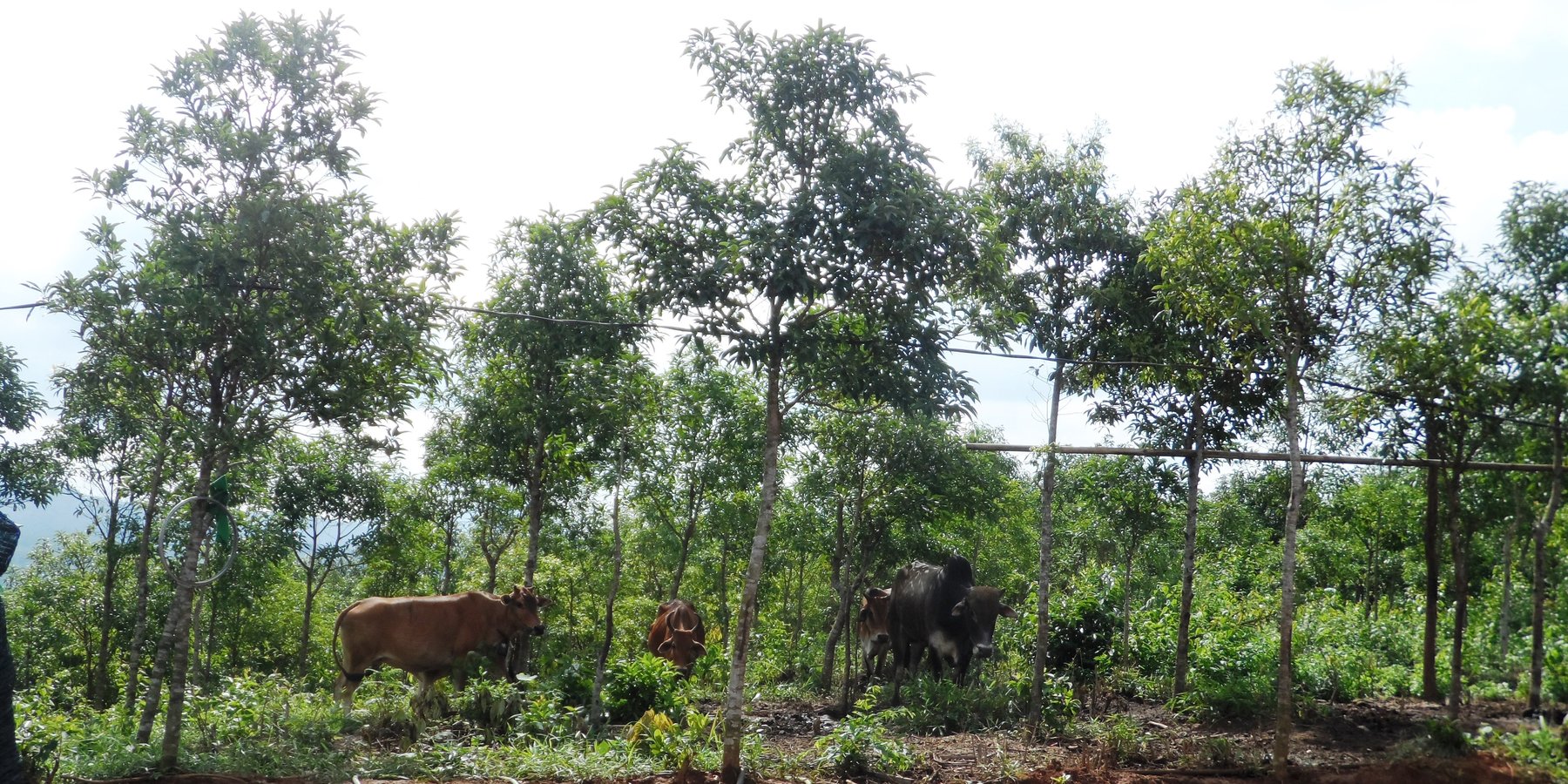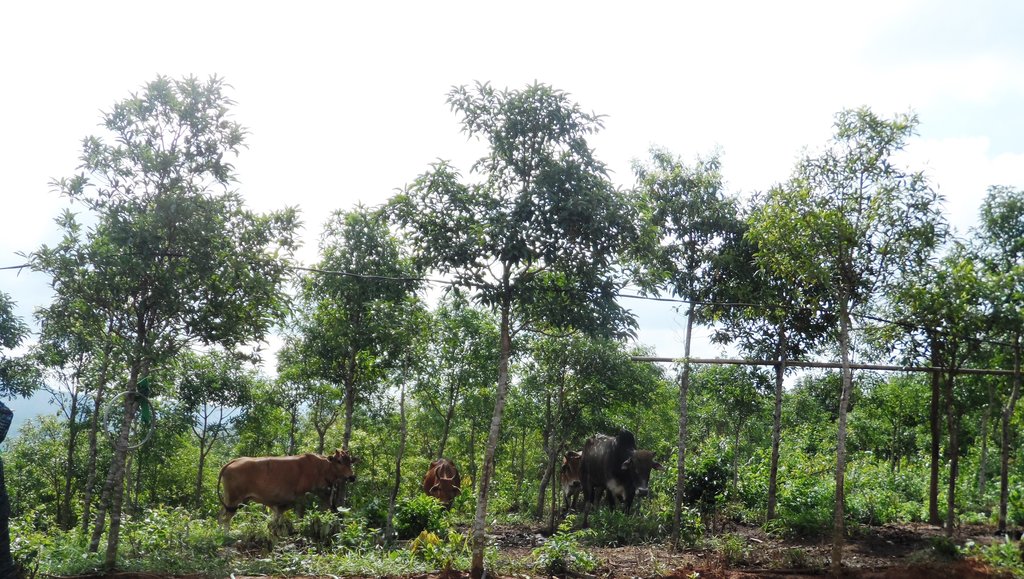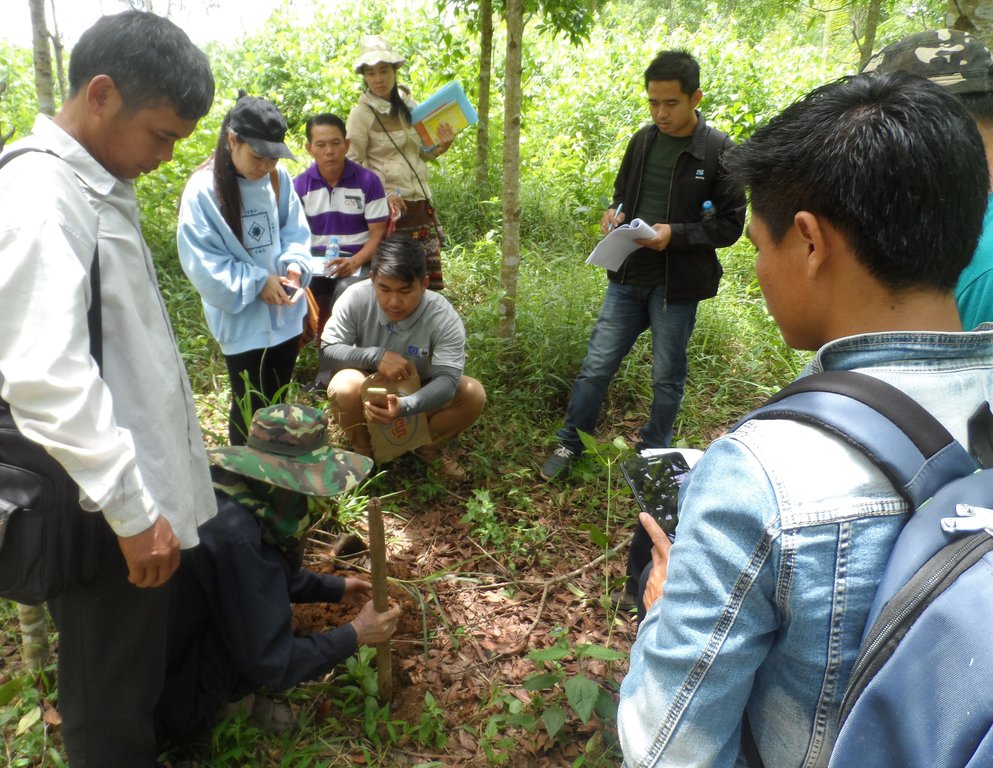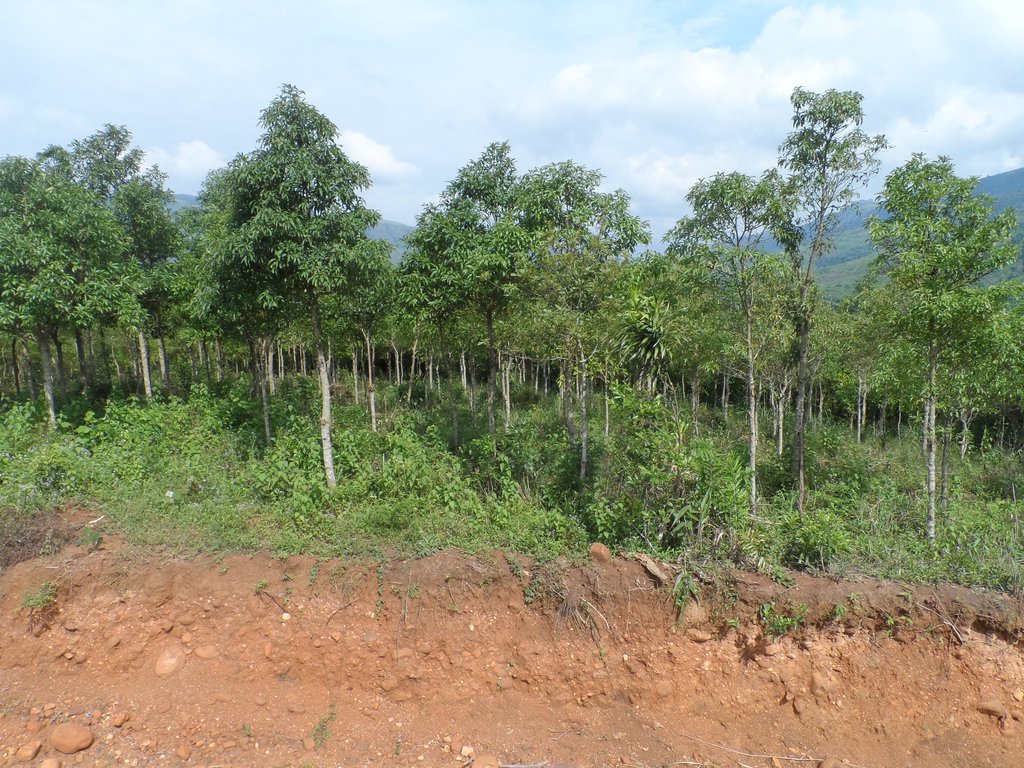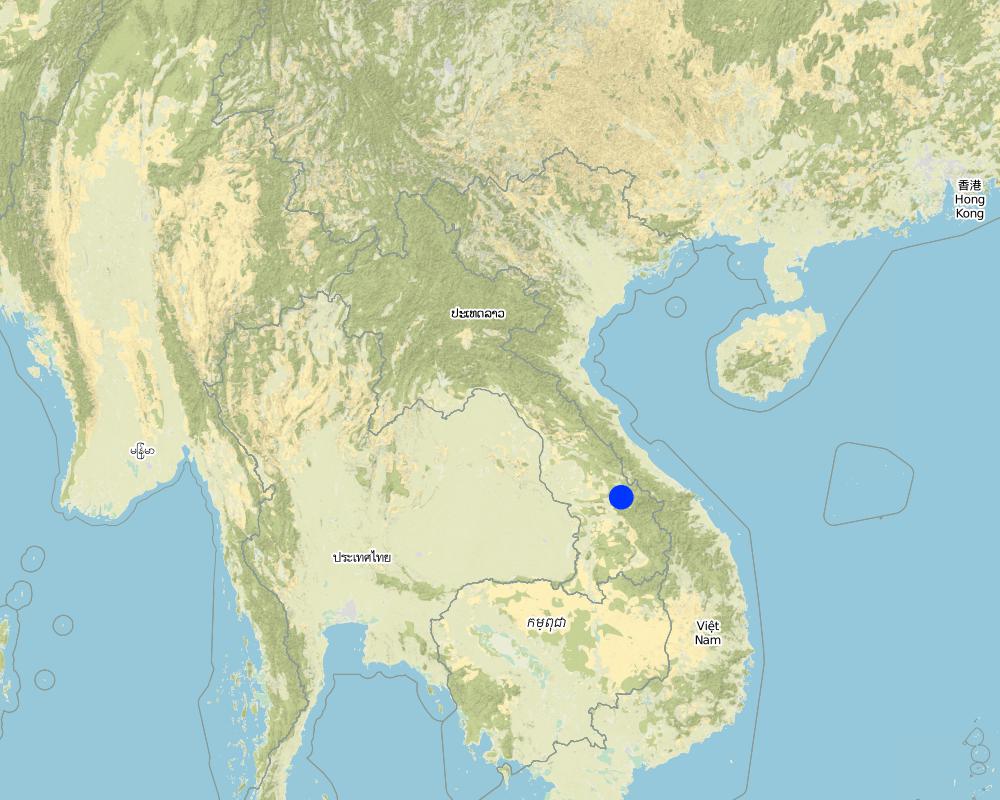Plantation of Yangbong (Persea kurzii) Trees on Slopes [Lao People's Democratic Republic]
- Creation:
- Update:
- Compiler: jimmy luangphithack
- Editors: sackmysay SANIDBOUNMEE, Bounthanom Bouahom, Pasalath Khounsy, kang phanvongsa, anousit namsena
- Reviewers: Nivong Sipaseuth, Nicole Harari, Stephanie Jaquet, Alexandra Gavilano
ການປູກກະແລວແຮງ
technologies_2307 - Lao People's Democratic Republic
View sections
Expand all Collapse all1. General information
1.2 Contact details of resource persons and institutions involved in the assessment and documentation of the Technology
Key resource person(s)
land user:
Sailava Konterp
Lao People's Democratic Republic
1.3 Conditions regarding the use of data documented through WOCAT
The compiler and key resource person(s) accept the conditions regarding the use of data documented through WOCAT:
Yes
1.4 Declaration on sustainability of the described Technology
Is the Technology described here problematic with regard to land degradation, so that it cannot be declared a sustainable land management technology?
No
2. Description of the SLM Technology
2.1 Short description of the Technology
Definition of the Technology:
Bong tree (Persea kurzii) plantation in slope area to increase forest canopy and to utilize the plantation areas for animal grazing such as cows and poultry.
2.2 Detailed description of the Technology
Description:
Bong tree (Persea kurzii), is a native tree species found in different regions in Lao PDR. In the past, farmers collected Bong barks from natural forest, as it contains gum and aromatic oils for the internationally very requested production of joss sticks. But the availability of wild Bong trees has been declining significantly. In order to keep this important source of income for farmers, Bong tree cultivation can be seen as valuable alternative to maintain the local livelihood whilst ensuring the preservation of the natural forests. The idea of commercial Bong tree plantation came from a Vietnamese trader (in 2000) who introduced Bong tree through a trial plantation. In 2006 land users who were experienced in the highly costly and labor-intensive coffee and pepper cultivation shifted to Bong tree cultivation. And in 2010, land users who gained lessons on seedling production and Bong tree cultivation from Vietnam established first trial cultivations on their farms. Later an IFAD Project in collaboration with the Samouey District Agriculture and Forestry Office promoted Bong tree plantation by providing organic fertilizer and advisory support to model households of the Samouey District .
Due to the easy handling and the potential benefits a number of farmers have been interested to participate. Bong trees are perennial and fast growing plants (first harvest of bark or log 6-7 years after planting) preferring humid climate and can be easily planted also on sloping terrain. Currently, Bong tree covers approximately 38 ha of land with an average increase of 1-2 ha/year. This land belongs to Mr. Sailava at Samoey district. The detailed method of Bong tree plantation is following:
1)Land preparation: first, it requires land clearance by removing weeds and bushes, along with hole digging in advance of rainy season (July to September);
2)Spacing: the appropriate spacing between the tree plants should measure about 2.5 x 2.5 meters. Staking is required throughout the plantation area before the holes can be dug. The planting holes are 25 cm x 25cm. The excavated topsoil should be stockpiled around the holes for refilling them later;
3)Planting and applying fertilizers: Bong seedlings need organic fertilizer (0.5kg/tree) that is mixed with soil and then filled in the holes. Finally the seedlings are gently placed in the holes by filling up with further topsoil. If the seedlings are tall, staking is required.
4)Maintenance: 2-3 months after planting ‒ only in case it is needed ‒ additional fertilizer will be added and/or weeding is carried out. The plant residues from weeding are used to cover the ground around the seedlings to keep soil moisture, and once decomposed, to provide natural organic matters to the soil. In conditions of dry climate and hard soil, watering is required to prevent soil cracking which is a cause of breaking tree’s roots and subsequently trees will die.
The advantages of planting Bong trees include direct income generation for households as well as increased forest canopy. It minimize the carbon emissions of slash-and-burn land use. The falling Bong tree leaves provide organic matters to soils, help retaining soil moisture and subsequently increase soil fertility. Under-story vegetation includes lianas and grasses that provide fodder for livestock. Three years after plantation, the land users can utilize the area for animal grazing such as cows and poultry. In fact, poultry can find earthworms around Bong trees which provide rich nutrition for animals. However, some disadvantages of planting Bong trees have to be mentioned as well: Some plantations may become shrubs where weeding is not conducted regularly. Poor maintenance provokes invasion of snakes, bees, and mosquitos.
2.3 Photos of the Technology
2.5 Country/ region/ locations where the Technology has been applied and which are covered by this assessment
Country:
Lao People's Democratic Republic
Region/ State/ Province:
Samou y district, Salavan province
Further specification of location:
Lavatai village
Specify the spread of the Technology:
- evenly spread over an area
If precise area is not known, indicate approximate area covered:
- 0.1-1 km2
Map
×2.6 Date of implementation
Indicate year of implementation:
2010
If precise year is not known, indicate approximate date:
- less than 10 years ago (recently)
2.7 Introduction of the Technology
Specify how the Technology was introduced:
- through projects/ external interventions
Comments (type of project, etc.):
IFAD project in collaboration with Samouy District of Agriculture and Forestry Office
3. Classification of the SLM Technology
3.1 Main purpose(s) of the Technology
- reduce, prevent, restore land degradation
- create beneficial economic impact
3.2 Current land use type(s) where the Technology is applied

Forest/ woodlands
- (Semi-)natural forests/ woodlands
- Tree plantation, afforestation
(Semi-)natural forests/ woodlands: Specify management type:
- Shifting cultivation
Tree plantation, afforestation: Specify origin and composition of species:
- Monoculture local variety
Products and services:
- Grazing/ browsing
- construction material (house, fence and furniture)
Comments:
Number of growing seasons per year: 1
Livestock density: 15 cows
3.4 Water supply
Water supply for the land on which the Technology is applied:
- rainfed
3.5 SLM group to which the Technology belongs
- agroforestry
- pastoralism and grazing land management
- integrated soil fertility management
3.6 SLM measures comprising the Technology

management measures
- M1: Change of land use type
3.7 Main types of land degradation addressed by the Technology

soil erosion by water
- Wg: gully erosion/ gullying

biological degradation
- Bc: reduction of vegetation cover
- Bq: quantity/ biomass decline
- Bf: detrimental effects of fires
3.8 Prevention, reduction, or restoration of land degradation
Specify the goal of the Technology with regard to land degradation:
- prevent land degradation
- reduce land degradation
4. Technical specifications, implementation activities, inputs, and costs
4.1 Technical drawing of the Technology
Technical specifications (related to technical drawing):
The holes for Bong tree seedlings are 20 cm in depth, 25 cm in width and 25 cm in length
The spaceace between plants is 2.5 x 2.5 m
Slope angle in that area is between 16 - 30 %
Density of plants is about 1600 plants/ha
Author:
Jimmy Luangphithuck
Date:
17/05/2017
4.2 General information regarding the calculation of inputs and costs
Specify how costs and inputs were calculated:
- per Technology area
Indicate size and area unit:
1 ha
other/ national currency (specify):
kip
If relevant, indicate exchange rate from USD to local currency (e.g. 1 USD = 79.9 Brazilian Real): 1 USD =:
8000.0
Indicate average wage cost of hired labour per day:
30,000
4.3 Establishment activities
| Activity | Timing (season) | |
|---|---|---|
| 1. | Bong tree nursery | November-Febuary |
| 2. | Land preparation | January-February |
| 3. | Dig the hole | July-August |
| 4. | Use bio fertilizer | August-September |
| 5. | Planting | August-September |
| 6. | Weeding in first 3 years | August-September and January-February |
| 7. | Weeding after year 4-6 | August-September |
4.4 Costs and inputs needed for establishment
| Specify input | Unit | Quantity | Costs per Unit | Total costs per input | % of costs borne by land users | |
|---|---|---|---|---|---|---|
| Labour | labor for hole digging | hole | 1600.0 | 500.0 | 800000.0 | 100.0 |
| Labour | labor for planting | hole | 1600.0 | 1000.0 | 1600000.0 | 100.0 |
| Labour | labor for cleaning | person-day | 60.0 | 30000.0 | 1800000.0 | 100.0 |
| Equipment | knife | piece | 20.0 | 20000.0 | 400000.0 | 100.0 |
| Equipment | hoe | piece | 20.0 | 35000.0 | 700000.0 | 100.0 |
| Equipment | shovel | piece | 20.0 | 35000.0 | 700000.0 | 100.0 |
| Plant material | Bong tree seedlings | tree | 1600.0 | 1000.0 | 1600000.0 | 100.0 |
| Total costs for establishment of the Technology | 7600000.0 | |||||
| Total costs for establishment of the Technology in USD | 950.0 | |||||
Comments:
The quantity of hole digging, planting and seedlings mention above is for 1 ha.
That mean in 38 ha the farmer will have 1600 hole x 38 ha = 60,800 holes, plantings and seedlings
So labor for hole digging cost in 38 ha is 500 x 60,800= 30,400,000 kip
Labor for planting cost in 38 ha is 1000 x 60,800= 60,800,000 kip
and Bong tree seedlings cost in 38 ha is 1000 x 60,800= 60,800,000 kip
4.5 Maintenance/ recurrent activities
| Activity | Timing/ frequency | |
|---|---|---|
| 1. | maintenance (weeding) | January and August each year |
| 2. | timber harvesting | |
| 3. | bark collection |
4.6 Costs and inputs needed for maintenance/ recurrent activities (per year)
| Specify input | Unit | Quantity | Costs per Unit | Total costs per input | % of costs borne by land users | |
|---|---|---|---|---|---|---|
| Labour | labor for weeding | person | 60.0 | 30000.0 | 1800000.0 | 100.0 |
| Labour | labor for timber harvesting | person | 100.0 | |||
| Labour | labor for bark collection | person | 100.0 | |||
| Fertilizers and biocides | Bio fertilizers | bag | 1000.0 | 15000.0 | 15000000.0 | 100.0 |
| Total costs for maintenance of the Technology | 16800000.0 | |||||
| Total costs for maintenance of the Technology in USD | 2100.0 | |||||
If land user bore less than 100% of costs, indicate who covered the remaining costs:
The Bio Fertilizer has been provided by the project.
4.7 Most important factors affecting the costs
Describe the most determinate factors affecting the costs:
Labour is an important factor especially for larger plantation areas that require more labour for maintenance
5. Natural and human environment
5.1 Climate
Annual rainfall
- < 250 mm
- 251-500 mm
- 501-750 mm
- 751-1,000 mm
- 1,001-1,500 mm
- 1,501-2,000 mm
- 2,001-3,000 mm
- 3,001-4,000 mm
- > 4,000 mm
Specifications/ comments on rainfall:
There is significant rainfall in most months of the year. The short dry season has little effect on the overall climate.
Indicate the name of the reference meteorological station considered:
https://en.climate-data.org/location/1063801/
Agro-climatic zone
- humid
5.2 Topography
Slopes on average:
- flat (0-2%)
- gentle (3-5%)
- moderate (6-10%)
- rolling (11-15%)
- hilly (16-30%)
- steep (31-60%)
- very steep (>60%)
Landforms:
- plateau/plains
- ridges
- mountain slopes
- hill slopes
- footslopes
- valley floors
Altitudinal zone:
- 0-100 m a.s.l.
- 101-500 m a.s.l.
- 501-1,000 m a.s.l.
- 1,001-1,500 m a.s.l.
- 1,501-2,000 m a.s.l.
- 2,001-2,500 m a.s.l.
- 2,501-3,000 m a.s.l.
- 3,001-4,000 m a.s.l.
- > 4,000 m a.s.l.
Indicate if the Technology is specifically applied in:
- not relevant
5.3 Soils
Soil depth on average:
- very shallow (0-20 cm)
- shallow (21-50 cm)
- moderately deep (51-80 cm)
- deep (81-120 cm)
- very deep (> 120 cm)
Soil texture (topsoil):
- medium (loamy, silty)
Soil texture (> 20 cm below surface):
- medium (loamy, silty)
Topsoil organic matter:
- medium (1-3%)
5.4 Water availability and quality
Ground water table:
5-50 m
Availability of surface water:
good
Water quality (untreated):
unusable
Is water salinity a problem?
No
Is flooding of the area occurring?
No
5.5 Biodiversity
Species diversity:
- medium
Habitat diversity:
- medium
5.6 Characteristics of land users applying the Technology
Sedentary or nomadic:
- Sedentary
Market orientation of production system:
- mixed (subsistence/ commercial)
Off-farm income:
- 10-50% of all income
Relative level of wealth:
- average
Individuals or groups:
- individual/ household
Level of mechanization:
- manual work
- mechanized/ motorized
Gender:
- women
- men
Age of land users:
- middle-aged
- elderly
5.7 Average area of land used by land users applying the Technology
- < 0.5 ha
- 0.5-1 ha
- 1-2 ha
- 2-5 ha
- 5-15 ha
- 15-50 ha
- 50-100 ha
- 100-500 ha
- 500-1,000 ha
- 1,000-10,000 ha
- > 10,000 ha
Is this considered small-, medium- or large-scale (referring to local context)?
- large-scale
5.8 Land ownership, land use rights, and water use rights
Land ownership:
- individual, titled
Land use rights:
- individual
Water use rights:
- open access (unorganized)
5.9 Access to services and infrastructure
health:
- poor
- moderate
- good
education:
- poor
- moderate
- good
technical assistance:
- poor
- moderate
- good
employment (e.g. off-farm):
- poor
- moderate
- good
markets:
- poor
- moderate
- good
energy:
- poor
- moderate
- good
roads and transport:
- poor
- moderate
- good
drinking water and sanitation:
- poor
- moderate
- good
financial services:
- poor
- moderate
- good
6. Impacts and concluding statements
6.1 On-site impacts the Technology has shown
Socio-economic impacts
Production
animal production
Comments/ specify:
Before the husbandry area was very limited in the forest. After active expansion of the Bong tree area by the mean of plantation, livestock got an ideal area for grazing and thus, the land user was able to enlarge his herd.
wood production
Comments/ specify:
Before Bong tree plantation the farmer collected wood and bark of Bong trees in the natural fores. After he planted Bong trees actively on his forest land he was able to increase the wood and bark production for construction purposes.
Income and costs
farm income
Comments/ specify:
Before, the farmer collected Bong tree material in the natural forest for selling. But the availability was very limited. Therefore, the cultivation of Bong trees brought better income.
workload
Comments/ specify:
Workload of the land user increased significantly due to the large area of bong tree plantation (38 ha).
Socio-cultural impacts
conflict mitigation
Comments/ specify:
Because some people cut his trees and steal the wood.
Ecological impacts
Soil
soil loss
Comments/ specify:
The Bong tree has an expansive root system that is effective in binding the soil on slopes, and so, this reduces and prevents soil erosion.
nutrient cycling/ recharge
Comments/ specify:
The grass growing naturally in the Bong tree area can be eaten by the livestock. The excrements of the animals mixed with the leaves of the Bong trees, serve as ideal manure for plants (Bong tree and grass ).
Climate and disaster risk reduction
fire risk
Comments/ specify:
The land user transformed the land from shifting cultivation by traditional method of slash and burn to a stable plantation area. The method of shifting cultivation is the main cause for fires in the local forests.
6.2 Off-site impacts the Technology has shown
impact of greenhouse gases
Comments/ specify:
Reducing of shifting cultivation and subsequently less fires/improved forest cover and subsequently higher area for carbon sequestration
6.3 Exposure and sensitivity of the Technology to gradual climate change and climate-related extremes/ disasters (as perceived by land users)
Gradual climate change
Gradual climate change
| Season | increase or decrease | How does the Technology cope with it? | |
|---|---|---|---|
| annual rainfall | increase | moderately |
Climate-related extremes (disasters)
Hydrological disasters
| How does the Technology cope with it? | |
|---|---|
| landslide | moderately |
6.4 Cost-benefit analysis
How do the benefits compare with the establishment costs (from land users’ perspective)?
Short-term returns:
very negative
Long-term returns:
very positive
How do the benefits compare with the maintenance/ recurrent costs (from land users' perspective)?
Short-term returns:
negative
Long-term returns:
positive
6.5 Adoption of the Technology
- 11-50%
Of all those who have adopted the Technology, how many did so spontaneously, i.e. without receiving any material incentives/ payments?
- 11-50%
Comments:
IFAD Project in collaboration with the Samouey District Agriculture and Forestry Office promoted Bong tree plantation by providing organic fertilizer and advisory support to model households of the Samouey District .
6.6 Adaptation
Has the Technology been modified recently to adapt to changing conditions?
No
6.7 Strengths/ advantages/ opportunities of the Technology
| Strengths/ advantages/ opportunities in the land user’s view |
|---|
| Acts as a counterbalance to slash and burn agriculture |
| Once the trees have been planted it facilitates the raising of livestock such as cattle and poultry and therefore reduces the workload involved in such farming activities |
| The plantation of bong trees further diversifies the sources of household income. |
| Strengths/ advantages/ opportunities in the compiler’s or other key resource person’s view |
|---|
| The Bong tree has an expansive root system that is effective in binding the soil on slopes, and this reduces and prevents soil erosion. |
| It reduces the loss of top soil during prolonged precipitation. |
6.8 Weaknesses/ disadvantages/ risks of the Technology and ways of overcoming them
| Weaknesses/ disadvantages/ risks in the land user’s view | How can they be overcome? |
|---|---|
| Due to the large area that is under the cultivation of Bong trees it makes it difficult to control and maintain the plantation. |
7. References and links
7.1 Methods/ sources of information
- field visits, field surveys
1 time
- interviews with land users
2 person
When were the data compiled (in the field)?
17/05/2017
Links and modules
Expand all Collapse allLinks
No links
Modules
No modules


